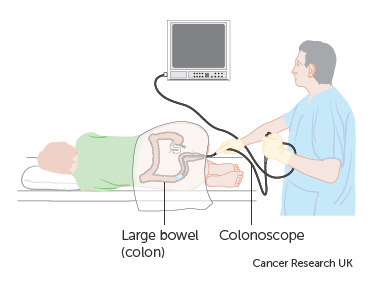A study looking at a device to find polyps in the bowel during a cancer screening test (The B-ADENOMA study)
Cancer type:
Status:
Phase:
This study was done to see if Endocuff Vision makes it easier to find polyps during a cancer screening test to look at the inside of the bowel. This test is called a sigmoidoscopy.
The study was open for people to join between 2017 and 2018. The team published the results in 2020.
More about this trial
Screening means looking for early stages of an illness before people have any symptoms. Bowel scope screening uses a thin flexible tube with a tiny camera on the end to look at the inside of the large bowel. Doctors also call this test a flexi scope or flexible sigmoidoscopy (flexi-sig).
Doctors can see polyps during the screening test.  are growths on the lining of the bowel. They are not cancer. But adenoma polyps can develop into bowel cancer over time.
are growths on the lining of the bowel. They are not cancer. But adenoma polyps can develop into bowel cancer over time.
A specially trained nurse or doctor (colonoscopist) uses the scope to look at the lower part of the bowel. They can remove polyps using a small wire loop.

This study looked at a new device called the Endocuff Vision, attached to the end of the scope. It holds back the folds of the bowel lining to give a better view. The research team hoped it would make it easier to see and remove polyps.
The main aims of this study were to find out if the Endocuff Vision:
- can help find adenoma polyps
- causes any discomfort or other side effects
Summary of results
Study design
This study was for people aged 55 or over who were having a routine bowel screening test.
They either had a standard flexi sigmoidoscopy test, or a flexi sigmoidoscopy test using the Endocuff Vision.
The research team looked to see how many people had adenoma polyps on the lining of their bowel.
Results
More than 3,000 people joined this study. They were put into 1 of 2 groups at random:
- half had a standard flexi sigmoidoscopy
- half had a flexi sigmoidoscopy using Endocuff Vision
The research team found that a similar number of people in each group had adenoma polyps. It was just over 1 out of 10 people (10%) in both groups:
- 12% of those who had the standard test
- 13% of those who had Endocuff Vision test
The number of people who had complications during the test was low and similar in both groups. Some people in the Endocuff Vision group had a higher level of discomfort.
Conclusion
The research team concluded that the Endocuff Vision didn’t make it easier to see adenoma polyps in the bowel in this study. But the number of people with adenoma polyps in the standard test group was higher than they expected. It is usually less than 1 out of 10 people (9%). So this makes it harder to be sure of these results.
More detailed information
There is more information about this research in the references below.
Please note, the journal articles we link to below are not in plain English. They have been written for healthcare professionals and researchers.
BowelScope: Accuracy of Detection Using Endocuff Optimisation of Mucosal Abnormalities (the B-ADENOMA Study): a multicentre, randomised controlled flexible sigmoidoscopy trial
C Rees and others
Gut, 2020. Volume 69, Issue 11. Pages 1959-1965.
BowelScope – Accuracy of Detection using ENdocuff Optimisation of Mucosal Abnormalities (The B-ADENOMA Study): A multicentre, randomised controlled flexible sigmoidoscopy trial
C Rees and others
Newcastle University website.
Accessed October 2022.
Where this information comes from
We have based this summary on the information in the articles above. Some of these have been reviewed by independent specialists ( ) and published in a medical journal. We have not analysed the data ourselves.
) and published in a medical journal. We have not analysed the data ourselves.
Recruitment start:
Recruitment end:
How to join a clinical trial
Please note: In order to join a trial you will need to discuss it with your doctor, unless otherwise specified.
Chief Investigator
Professor Colin Rees
Supported by
ARC Medical Design Ltd
South Tyneside NHS Foundation Trust
If you have questions about the trial please contact our cancer information nurses
Freephone 0808 800 4040



